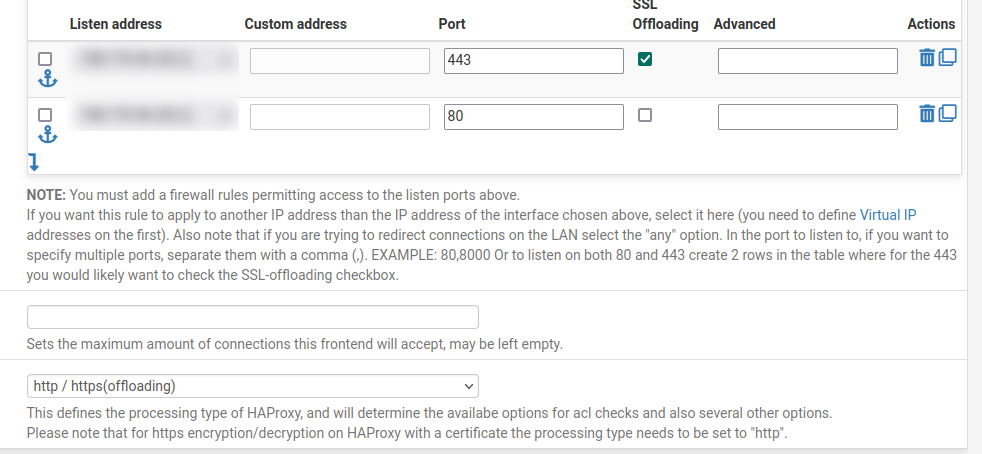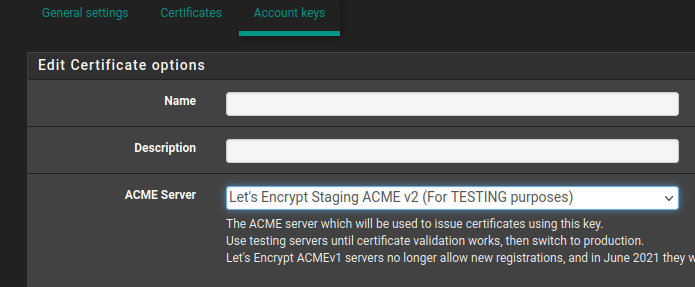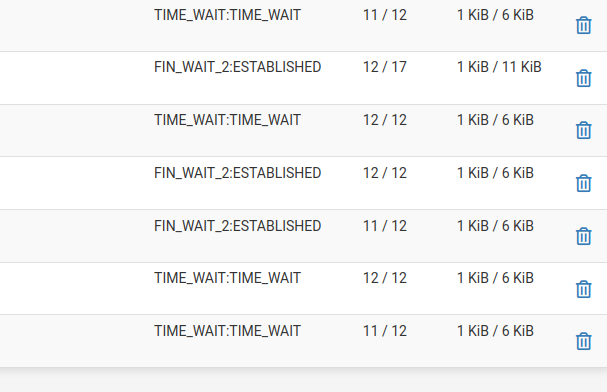SSL certs handling and HAproxy
-
Some things are getting mixed up in the thread. That's why I suggested working on this one stand alone server first. Once I see how that is working, that will help me to understand how things need to be set up.
First, I'm only working on one firewall, not multiples in trying to solve this.
I have two different things going on.
1: I thought haproxy was handling the three web servers I've talked about and we've now found that this was not the case.
These servers have their own SSL certificates, not using ACME on the firewall.
When I swap from a NAT rule to a WAN rule, all traffic to all three servers stop.2: I've set up a test web server, just one server, to see if I can use the SSL certificate on pfsense instead of the web server, to learn about doing this using pfsense, ACME and haproxy.
In this case, I have ACME set up with a valid cert on pfsense and wanted to learn about this by having pfsense handle the ssl cert for the web server.
So far, nothing has worked. In this case, I've also shared images of the rules, setup etc.
The best I've been able to get in terms of reaching the web service is getting an error in the browser, complaining about HSTS which is odd because HSTS is disabled on the web server.This seems to imply that things are set up ok on pfsense but something on the web server is not.
-
That implies that you're hitting HAProxy with http and it's only configured for https.
Try connecting to to with https. Do you see the expected states opened in the firewall. Do you see the expected cert on the client?
-
@lewis
about the port he was talking about this settings
the default is 80 or 443 for https, if you don't chage this port the pfsense gui take control of the traffic instead of haproxy
if you saw the pfsense cert you are near the solution, change that setting and you should see the cert of haproxy
-
One thing I mentioned and will again is that the pfsense GUI is set to a custom port without an SSL certificate.
Nothing will hit the pfsense GUI other than if someone got the correct port set in the Advanced/Admin Access/TCP port settings.
That port is also blocked and allowed to only one or two IPs so no one can get to the GUI.Unless I'm missing something again?
Also, I double checked and there are no services on port 80 or 443 for the primary pfsense IP, all services are using ports with their own VIPs.
-
Great so that can't be an issue then.
So do you see states? Do you see the ACME cert on the client?
-
@stephenw10
That's the problem with posts when they get so long. I had mentioned that once or twice :).I can check the states but we're talking about the single server that has the cert on pfsense ACME now right?
As mentioned, I can get back to the load balanced stuff later. It would be nice to see this working first.On that web server, I've now added a self signed cert so that it can respond to https requests without needing the real FQDN cert on the server.
That cert is on pfsense ACME.The server accepts port 80 and 443, no redirect enabled right now so I can see any traffic coming to it.
When I run an ssl test, I see the the correct ACME cert details showing up but I also see;
Trusted: We were unable to verify this certificate
In the browser, I see; Error code: SEC_ERROR_UNKNOWN_ISSUEROddly, I do see some connections getting to the server;
www.domain.com 10.0.0.1 - - [20/Dec/2023:14:36:19 -0700] "GET /action/social/login/facebook?ossn_ts=1702991375&ossn_token=xxx HTTP/1.1" 301 20 159565 159325 "-" "Mozilla/5.0 (compatible; MJ12bot/v1.4.8; http://mj12bot.com/)"
and
www.domain.com 10.0.0.1 - - [20/Dec/2023:14:37:25 -0700] "GET / HTTP/1.1" 301 4691 181606 181062 "-" "Mozilla/5.0 (compatible; MJ12bot/v1.4.8; http://mj12bot.com/)"Notice those connections are coming from 10.0.0.1 which in this case, is the firewall so I think that's a good thing. It means it's intercepting the traffic or haproxy is, right?
Next, looking at states while trying to connect to said web server, I see nothing what so ever.
-
I'm not sure why I didn't notice before or maybe there weren't any when I looked but;
I do see connections but they are all port 80 no matter if I use http or https from a remote browser/client.
-
Using TOR, I always get an HSTS notice but using other browser, I only get a cert warning.
As mentioned, I do not have HSTS enabled on this server at the moment.I'm confused on why some traffic is showing up however.
-
Ok that mostly looks good. The LAN side states should be http if HAProxy is configured to use that. It's independent of whatever the front end connections are.
I expect to see states on WAN too though, from the client to HAProxy on the VIP?
That cert error look like it might just be a cert problem. Unknown issuer is odd though. ACME setup not quite right? Still using the testing CA maybe?
-
Ok that mostly looks good. The LAN side states should be http if HAProxy is configured to use that. It's independent of
whatever the front end connections are.The haproxy front end is set to both 443 and 80. I shared an image above of some of the settings.
I expect to see states on WAN too though, from the client to HAProxy on the VIP?
None, all LAN in the states view.
That cert error look like it might just be a cert problem. Unknown issuer is odd though. ACME setup not quite right? Still
using the testing CA maybe?I don't see any options for live or testing. How can I check that?
-

-
It's ACME that has options for production and testing.
You are seeing no WAN side states at all?
If so are you seeing blocked traffic on WAN?
-
@stephenw10 said in SSL certs handling and HAproxy:
It's ACME that has options for production and testing.
I looked though the settings but don't see anything about testing.
The only options are enable or disable in a couple of sections.You are seeing no WAN side states at all?
If so are you seeing blocked traffic on WAN?There's lots of WAN traffic, just nothing to that server.
-
Hmm, no states on WAN is an issue. How are you testing?
Do you see states or bytes on the WAN firewall rue that should be passing that?
The acme testing option is here:

But of nothing is even reaching WAN that's probably not the issue
-
@stephenw10 said in SSL certs handling and HAproxy:
Hmm, no states on WAN is an issue. How are you testing?
Do you see states or bytes on the WAN firewall rue that should be passing that?
The acme testing option is here:

But of nothing is even reaching WAN that's probably not the issue
The WAN seems to have a lot of traffic, just not to this web server.
Thanks for the image, it turns out it is in testing mode.
I've changed it to LE production but still no go. -
Just to confirm, I should be seeing traffic on WAN to the web server, in this case, 10.0.0.180.
-
Alright, I do see traffic on the WAN from public IPs to the VIP.
It's looking like the problem is only on the web server now?
-
Yes to the VIP where the HAProxy front end is listening.
Ok those states look better, two way traffic at least. They are not going to stay established if the client is dropping the connection due to a bad cert.
If you examine the cert on the client when you try to connect is it using a valid CA?
If ACME was set to use the staging server it wouldn't be valid. It would need to update with the real production cert before clients recognise it as signed by a valid CA.
-
Yes, I think we're getting somewhere.
This is what I'm seeing about the certificate;--- Server certificate subject=CN = domain.com issuer=C = US, O = (STAGING) Let's Encrypt, CN = (STAGING) Artificial Apricot R3 --- No client certificate CA names sent Peer signing digest: SHA256 Peer signature type: RSA-PSS Server Temp Key: X25519, 253 bits --- SSL handshake has read 4661 bytes and written 409 bytes Verification error: unable to get local issuer certificate --- New, TLSv1.3, Cipher is TLS_AES_256_GCM_SHA384 Server public key is 2048 bit Secure Renegotiation IS NOT supported Compression: NONE Expansion: NONE No ALPN negotiated Early data was not sent Verify return code: 20 (unable to get local issuer certificate) -
Aha! OK then that's the first hurdle. The client is connecting to HAProxy at least.
So you need to renew the cert now it's set to the production server.
Then see what is broken next.
